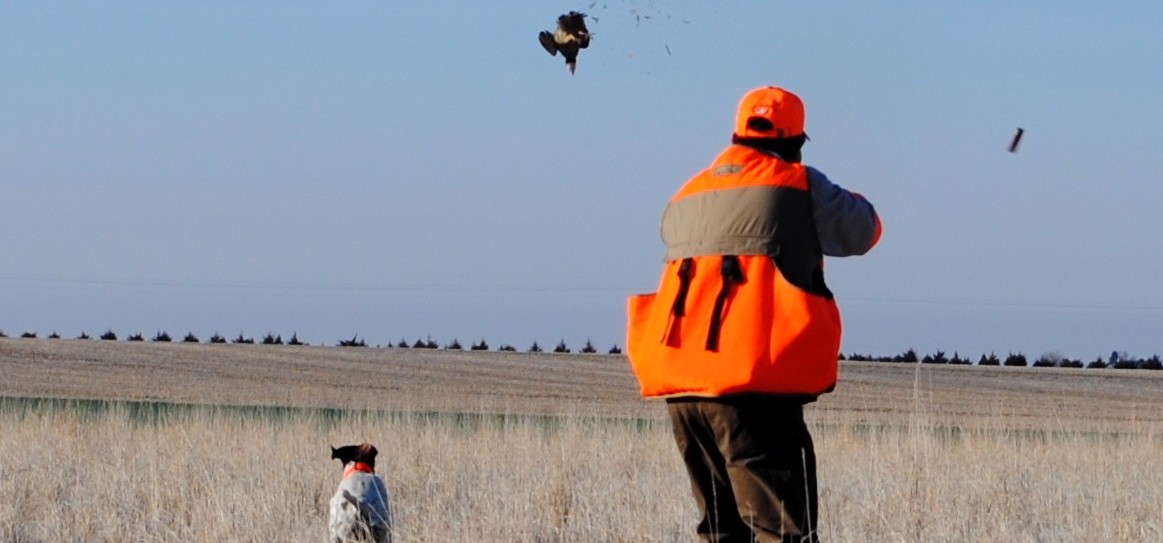Field Dog First Aid Kit by Shawn K. Wayment, DVM
The following is a list of the things that I personally carry in my field dog first aid kit. Rarely have I needed more than what is listed below. If I needed more than this, I would pack up and head for the nearest veterinary facility. Trial dogs are faced with numerous perils in the field, so it is very important to carry a field first aid kit and know a few basic bird dog first aid procedures. Another important item is to choose a family veterinarian that understands field trial dogs and the rigors that they are challenged with while in the field. Contact your veterinarian and have them help you get a good first aid kit together for your days afield.
1. Ointments: Neosporin, Silvadene Cream (for cuts and burns), triple antibiotic eye ointment, Panolog/Animax or some other topical antibiotic/hydrocortisone ointment.
2. Betadine Solution: Povodone/Iodine 1% solution mixed with H2O to weak “iced tea color” for cleaning out wounds (punctures or lacerations). I typically use a syringe and an 18 gauge needle to flush wounds. This gives enough pressure/force to clean off debris and bacteria.
3. Hydrogen Peroxide: I only carry this to induce vomiting if my dogs ingest something they should not have eaten. It also can be combined with baking soda and Ivory dish soap to aid in de-skunking your bird dog. I never use hydrogen peroxide on a wound because it is more damaging to the tissue due to free radical damage than beneficial.
4. Saline Contact Rinse/Solution: Used to clean the eyes out/rinse the eyes. Rinse the eyes from medial to lateral.
5. Clavamox (Antibiotic): A good all around antibiotic for cuts and infections, etc. 250 mg for a 40 lb dog twice daily for 7 to 10 days is a typical dosage.
6. Metronidazole (Antibiotic): Great drug for treating Giardia and general diarrhea. The dosage is about 25 mg/kg or 500 mg per 45 lbs of dog twice daily for 8 days. Don’t leave home without it!
7. Ear Cleaner or Wash: Any good quality one will do the job.
8. Benadryl: For allergic reactions. The dosage is 1 to 2 mg per lb of bird dog or one OTC capsule per 25 pounds every 8 to 12 hours as needed for allergic reaction.
9. EMT Gel: Or some other form of collagen gel for rapid wound healing.
10. Rimadyl or Other Dog Approved NSAID: For swelling or pain. Rimadyl is giving at 1 mg per lb twice daily as needed.
11. Syringes of Various Sizes: I like the 12 cc curved tip one for cleaning out debris from wounds. A 12 cc syringe with an 18 gauge needle can give enough force to clean out a wound. You may want some 3 cc ones as well for injectable Lidocaine (2%) if you are going to suture some wounds. Can use a plastic case from a 20 gauge syringe for tip of the tail protectors (especially for pointer/setter people).
12. Gauze or Store Bought Muzzle: To prevent from being bit by an injured dog. Learn how to make a gauze muzzle—it is easy and can prevent unnecessary harm to you.
13. Bandage Material: Vet wrap, Elastikon, Telfa pads or other non-adhesive dressings, gauze and cotton padding for support wrap. I always carry duct tape! 2 x 2 or 4 x 4 gauze is also very handy to have around.
14. Dog Boots and Athletic Padding and Zonas Tape: These also work well for wraps of the feet.
15. Lidocaine (2%) Injectable: If you are going to suture wounds.
16. Cotton Tip Applicators: Q-Tips work fine. These can be used to help remove things (grass awns, fox tails, etc) from the eyes.
17. Kaopectate: Works very well for diarrhea. I usually give 10 mL (1 mL is equivalent to 1 cc) every 6 to 8 hours to an average sized 50 lb dog.
18. Suture Material and Stapler: I use Nylon to suture most skin lacerations. A stapler is a very effective method for closing up skin gashes. I would clip the hair around the wound and flush it using a curved tip syringe or a syringe with a needle prior to stapling it.
19. NutriCal Gel: This is an excellent, quick source of calories for a working filed dog. You can order this from Drs. Foster & Smith. I always have a few tubes in my pack.
20. Proparacaine Ophthalmic Topical Eye Drops: This is for numbing the eye if you need to remove a foreign object.
21. Tuff Pad/Foot or Copper Tox: This will help cut pads and protect the feet.
22. Needle Holders: Suturing wounds.
23. Hemostats or Leatherman Tool: For quill or cactus needle removal.
24. Digital Thermometer (Normal dog’s temp is 100 to 102.8 degrees F).
25. A Good Dog Brush
26. Space Blanket
27. Tissue Forceps (Tweezers)
28. Matches
29. Head Lamp or Other Light Source.
30. A Good Dog First Aid Book: (Field Guide: Dog First Aid Emergency Care for the Hunting, Working, and Outdoor Dog, Randy Acker, DVM).
31. Caloric Dense Canned Dog Food: I always have some cans of dense calorie canned dog food or GI canned food just in case.
Guns & Roosters Hunting Preserve
California pheasant hunting like the good ole days!………….Celebrating our 33rd season.
